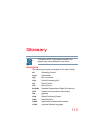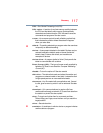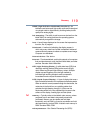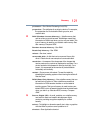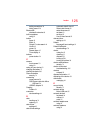
Glossary
119
HDMI (High-Definition Multimedia Interface)—An
interface used to transmit high quality audio and video signal
via a single cable in digital format, providing better picture
quality than analog signal.
hot swapping—The ability to add or remove devices from the
tablet while it is running and have the operating system
automatically recognize the change.
I
icon—A small image displayed on the screen that represents a
function, file, or program.
interlaced—A method of refreshing the display screen, in
which only every other line of pixels is refreshed. Interlaced
screens take two passes to create a complete screen image.
Compare
non-interlaced.
internal device—See
device.
Internet—The decentralized, world-wide network of computers
that provides electronic mail, the World Wide Web, and other
services. See also
World Wide Web.
L
LED (Light Emitting Diode)—A solid state lamp (SSL) that
uses light-emitting diodes (LEDs) as the source of light,
which offers long life and high efficiency output. Multiple
diodes are used together, since the light created by
individual light-emitting diodes is small compared to
incandescent and compact fluorescent lamps.
LCD (Liquid Crystal Display)—A type of display that uses a
liquid substance between two transparent electrode panels.
When an electric current passes through the electrodes, the
molecules in the liquid form a crystalline pattern that
polarizes the light passing through it. A filter over the
electrodes permits only non-polarized light to pass to the
surface of the display, creating light and dark pixels.
M
memory—Typically refers to the tablet’s main memory, where
programs are run and data is temporarily stored and
processed. Memory can be volatile and hold data
temporarily, such as RAM, or it can be nonvolatile and hold
data permanently, such as ROM. A tablet’s main memory is
RAM. See also
RAM
,
ROM.
microprocessor—See
Central Processing Unit (CPU).





